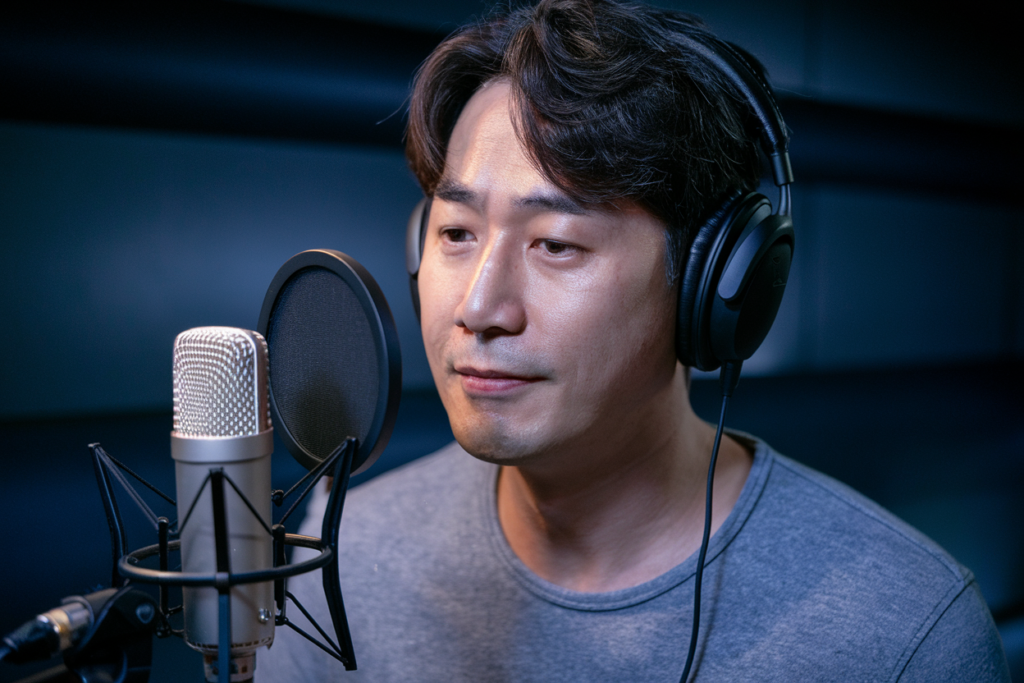Key Takeaways
- Cultural Importance: Lip syncing is integral to Korean entertainment, allowing performers to focus on choreography while delivering high-quality audio.
- Unique Challenges: Performers face issues such as voiceover recording discrepancies, complex dance routines, and language nuances that complicate synchronization.
- Language Complexity: The distinct phonetics of the Korean language can lead to mismatches between spoken words and lip movements, making precise synchronization difficult.
- High Performance Standards: K-pop artists are under immense pressure for flawless performances, which can result in noticeable discrepancies during live shows if not perfectly executed.
- Rigorous Training: Extensive training regimens help performers master both vocal delivery and choreography, enhancing their ability to synchronize lips with pre-recorded audio effectively.
- Audience Expectations: Fans closely scrutinize performances; any noticeable lip sync issues can lead to disappointment despite understanding the technical challenges involved.
Ever wondered why Korean lip syncing is so challenging? You’re not alone. Many fans of K-pop and Korean dramas have noticed that the synchronization between the audio and performers’ lips can sometimes feel off, leaving you scratching your head.
Understanding Korean Lip Syncing
Korean lip syncing poses unique challenges due to cultural practices and performance expectations. This section delves into the factors influencing this phenomenon.
Cultural Significance of Lip Syncing
In Korean entertainment, particularly in K-pop and dramas, lip syncing plays a vital role. Performers often rely on pre-recorded audio tracks to deliver polished performances. This practice allows for high-quality sound production while ensuring that performers can focus on choreography and stage presence. The emphasis on visual spectacle means that precise synchronization is crucial but not always achieved, leading to noticeable mismatches during live shows or broadcasts.
Common Challenges Faced by Performers
Lip syncing in Korea presents several challenges for performers:
- Voiceovers: Many artists record their vocals in studio environments separate from live performances, creating potential gaps in synchronization.
- Choreography: Complex dance routines require significant physical exertion. Juggling intense movements with vocal delivery complicates achieving perfect timing.
- Language Nuances: Korean language phonetics differ from other languages, making it challenging to match spoken words with pre-recorded sounds seamlessly.
- Technical Limitations: Variability in sound equipment and venue acoustics can affect how well audio aligns with visuals during live performances.
These factors contribute to the overall difficulty of maintaining consistent lip sync quality across various formats.
Language Barriers
Language barriers present significant challenges in Korean lip syncing. The intricacies of the Korean language, including its phonetics and pronunciation, complicate the synchronization process for performers.
Phonetics and Pronunciation
Korean phonetics differ markedly from those of English or other languages. Certain sounds in Korean don’t have direct equivalents in many other languages, causing difficulties when translating lyrics. This discrepancy can lead to mismatches between spoken words and lip movements. For instance, some vowel sounds may require different mouth shapes than what’s used in English. Performers often face hurdles adapting their articulation to keep pace with pre-recorded audio tracks, particularly during live performances where precision matters.
Rhythm and Timing
Rhythm and timing also play critical roles in successful lip syncing. Korean music often features unique rhythmic patterns that can vary significantly from Western styles. Adapting to these rhythms necessitates quick adjustments in how performers match their lips to the beat of the track. Furthermore, when voiceovers are involved, such as those done by voice artists for animations or dramas, performers must manage additional layers of complexity—aligning their expressions not just with lyrics but also with emotional delivery captured by a voiceover actor’s performance.
Performance Expectations
Korean entertainment sets high performance expectations, particularly in K-pop and dramas. The emphasis on polished presentations leads to a reliance on pre-recorded audio tracks, enabling performers to prioritize choreography and stage presence. This focus can create challenges when live performances reveal mismatches between audio and visual elements.
High Standards in K-Pop
K-pop artists face immense pressure to deliver flawless performances. They undergo rigorous training that emphasizes not just singing but also dancing, acting, and connecting with fans. This multifaceted skill set raises the bar for synchronization between their lip movements and the accompanying audio. The use of voiceovers adds complexity; artists must align their expressions with both the lyrics they perform and the emotional nuances conveyed by voiceover actors. Mismatches during live shows can lead to noticeable discrepancies, which may disappoint fans expecting seamless execution.
Fans’ Perception and Reactions
Fans are highly attuned to performance quality, often scrutinizing every detail of a live show. When lip syncing appears off, reactions can vary from confusion to disappointment. Many audience members recognize that pre-recorded audio is standard practice for achieving high production values but still expect a level of authenticity during live events. Some may even defend performers by attributing mismatches to technical difficulties or complex choreography rather than lack of talent or dedication. Ultimately, understanding these dynamics fosters appreciation for the unique pressures faced by Korean entertainers while balancing artistry with audience expectations.
Training and Preparation
Training and preparation play crucial roles in mastering lip syncing within Korean entertainment. The process isn’t just about performing; it requires dedication, discipline, and an understanding of the intricacies involved.
Rigorous Practice Regimens
Performers engage in rigorous practice regimens that encompass singing, dancing, and acting. These multi-faceted training schedules allow artists to hone their skills while ensuring they can synchronize their lips with pre-recorded audio tracks effectively. Daily rehearsals often include vocal exercises that focus on timing and pronunciation in Korean, which can significantly affect the accuracy of lip movements. Mastering choreography is equally vital; intricate dance routines demand precise coordination between physical movements and vocal delivery. This level of preparation helps minimize discrepancies during live performances.
Influences of Professional Training
Professional training influences every aspect of a performer’s abilities. Many artists undergo extensive instruction from seasoned professionals who specialize in voice work and performance techniques. This training emphasizes not only vocal quality but also emotional expression aligned with lyrics, enhancing overall performance authenticity. Voice actors contribute to this dynamic by providing voiceovers that require performers to match their expressions closely with the recorded audio’s tone and emotion.
Through comprehensive training, performers develop a keen understanding of rhythm and pacing specific to Korean music styles. This knowledge proves essential when adapting quickly to shifts in tempo or lyrical phrasing during live shows, helping them maintain synchronization even amidst complex choreography.
With such intensive preparation behind them, it’s no wonder expectations run high for these entertainers as they navigate the challenges inherent in delivering flawless performances while engaging their audience fully.
Conclusion
Korean lip syncing presents a unique set of challenges that can perplex both performers and fans alike. The intricate dance between audio tracks and physical expression demands precision and adaptability. As you watch your favorite K-pop artists or actors, remember the immense pressure they face to maintain flawless synchronization under intense scrutiny.
The cultural significance behind their performances adds layers to this complexity. While pre-recorded audio often enhances production quality, it also creates expectations for authenticity during live shows. Understanding these dynamics can deepen your appreciation for the artistry involved in Korean entertainment, revealing just how much effort goes into delivering those captivating moments on stage.
Frequently Asked Questions
What is lip syncing in Korean entertainment?
Lip syncing in Korean entertainment refers to the practice where performers use pre-recorded audio tracks during performances. This technique allows them to focus on choreography and stage presence while ensuring a polished delivery of their songs.
Why do K-pop idols sometimes appear out of sync?
K-pop idols may seem out of sync due to various factors, including language nuances, complex choreography, and technical limitations. These elements can lead to mismatches between the audio and their lip movements during live shows.
How does the Korean language affect lip syncing?
The intricacies of the Korean language can complicate synchronization because phonetic differences may cause discrepancies between spoken words and lip movements. Performers must adapt quickly to match lyrics with their expressions.
What are the challenges faced by performers in K-pop?
Performers face challenges such as high performance expectations, voiceovers, intricate choreography, and unique rhythmic patterns in music. These factors make it difficult to maintain consistent lip sync quality across different formats.
How important is training for mastering lip syncing?
Training is crucial for mastering lip syncing in K-pop. Performers undergo rigorous practice that includes vocal exercises focusing on timing and pronunciation, which significantly enhance their ability to synchronize with pre-recorded audio effectively.
Do fans expect authenticity during live performances?
Yes, fans often expect a level of authenticity during live events despite knowing that pre-recorded audio is standard for high production values. Discrepancies between audio and performance can lead to mixed reactions from audiences.
How do cultural practices impact lip syncing in Korea?
Cultural practices play a significant role as they dictate performance standards in Korea. The emphasis on flawless execution raises expectations for synchronization between performers’ lips and the accompanying audio tracks.
What common reactions do fans have toward mismatched performances?
Reactions range from confusion or disappointment when noticing mismatches to understanding or defending artists by attributing issues to technical difficulties or choreography challenges instead of lack of talent or effort.







